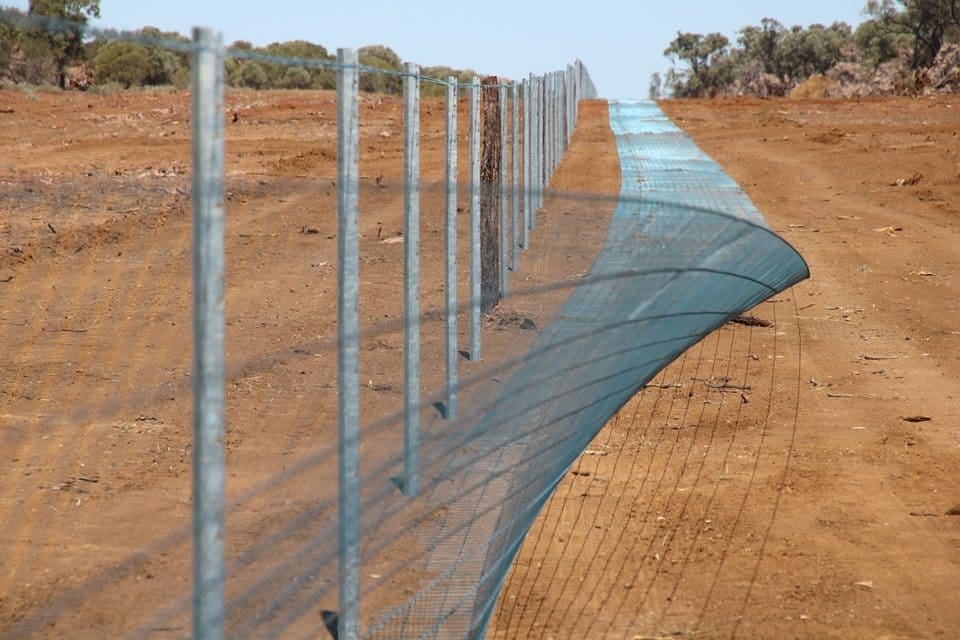
The final section of a cluster fence being erected on Glenaras, near Ilfracombe in central western Qld
AN economic analysis has determined that up to one million sheep could be returned to Queensland’s central western region, if current and proposed exclusion fencing projects are fully executed.
Data from the Remote Area Planning and Development board’s recent call for cluster fencing project expressions of interest has been analysed and if funded, when combined with current Round 1 and 2 fencing projects, would see 2.2 million hectares of country protected by exclusion fencing, across 174 grazing properties.
Cattle have largely displaced sheep in large parts of Queensland’s Central west, due to wild dog predation pressure.
The fully-executed projects would provide a $3.76 regional benefit per year for every $1 of Government expenditure, the independent study found, and a $1.18 increase in gross margin every year for every $1 spent on CAPEX by participating producers.
Director at Williams Hall Chadwick, Andrew Perkins, who is leading the economic analysis of the program, said at the beginning of the project 15 months ago, RAPAD set an ‘aspirational goal’ of having one million sheep in RAPAD’s Queensland Feral Pest Initiative (QFPI) region after 10 years, thanks to cluster fencing.
“Looking at the numbers achieved with rounds 1 and 2, and if the current third round of expressions of interest is successful, it has the potential to allow sheep numbers to expand to one million head, without further fencing, over the remainder of that 10 year period,” Mr Perkins said.
Payback in one year
The study included a new metric calculated on the recent EOI data provided by interested producers, which found that for every $1 the property owners contribute to the cluster fence, they would get an increased gross margin of $1.49 per year.
“In other words, payback in one year,” Mr Perkins said.
“That might seem unrealistic, but that is the way the numbers come out. If a producer spent $105,000 on their contribution to fencing, they would see an increased gross margin of $157,000. This is true regional economic development,” he said.
The data is supported by the recent Regional Australia Institute report which highlighted bringing back sheep as one of six priority areas for the RAPAD program, and the region.
The Institute’s report indicated that cluster fencing could provide “potential regional economic growth to $38.8 million annually through increased gross margin from sheep production, stimulating jobs for an additional 158 people in the industry.”
Fences delivering control, confidence, investment
Mr Perkins recently spent time in the region meeting with a number of the established RAPAD clusters, and a key theme from all meetings was that fences were delivering control, confidence and investment.
“As the fencing projects are nearing completion, cluster members felt they were gaining financial and environmental control of their properties and operations, and this control gave them confidence to look to the future and invest in hiring more staff and providing jobs and additional infrastructure,” he said.
“This is almost the opposite to what producers would probably traditionally be thinking after five years of drought and looking towards what could be another dry summer.”
Chairman of RAPAD, Rob Chandler agreed.
“People keep coming up and telling me we know that next year we will be fenced and we will have stopped everything from the outside, and we can just work on what is inside,” Mr Chander said.
“To me, confidence is the return landholders are currently getting: confidence about their futures from the achievement of getting fences in place. Producers getting control back will be a massive thing.”
Third round will protect 613,000ha of country
The recent third round of RAPAD cluster fencing expressions of interest attracted submissions from 10 cluster groups of properties, numbering 50 properties in total, wanting to erect 1054km of fencing to protect 613,138 ha of country.
If approved, the projects will require $3 million in funding from Government, matched by $5.2 million in private investment.
From these third round projects, sheep numbers are projected to grow from 70,000 to 338,000, delivering an expected net increase in jobs of 53; and an expected increase in sheep gross margin of $10.2m, from $1.5m to $11.7m.
Mr Chandler said the RAPAD board made the commitment to approach the Government asking for an additional $5 million for cluster fencing in the region, presenting Premier Palaszczuk with the request when she visited Ilfracombe earlier this year.
“This expressions of interest data demonstrates to Government the ongoing desire and economic return more funding will bring to our region,” he said.
“This funding is about more than a fence – this is regional economic development. It’s about creating jobs in the region, empowering people and giving them back control of their time, finances and wellbeing and delivering the most significant industry infrastructure for decades,” Mr Chandler said.
Backed by the RAI report, RAPAD continued to advocate to the Queensland and Australian Governments for the progression of strategic cluster fencing in the local government areas of Barcaldine, Longreach, Blackall-Tambo, Winton, Barcoo, Boulia, Richmond, McKinlay and Flinders shires, he said.
The Queensland Feral Pest Initiative has received funding through the Queensland Government to support the growth of a productive and prosperous food and fibre sector in the state, and the Australian Government Agricultural Competitiveness White Paper, the Australian Government’s plan for stronger farmers and a stronger economy.
Click here to view the RAPAD cluster fencing map, highlighting round one and two projects completed or nearing completion.
Click the link below to view a short video profiling exclusion fencing participants, Dave Owens and Amy Macintosh.
https://youtu.be/j-lKqpvVwZg
